#sea spiders
Explore tagged Tumblr posts
Text

The Entomologist's Text Book. Written and illustrated by John Obadiah Westwood. 1838.
Internet Archive
IDs via Wikimedia;
Goneplax rhomboides (syn:Goneplax angulata). Astacilla longicornis (syn:Arcturus longicornis). Limnoria lignorum (syn:Limnoria terebrans). Pycnogonum litorale (syn:Pycnogonum balaenarum). Julus terrestris (Common millipede) Dysdera erythrina Petrobius maritimus (Sea or Shore bristletail) Haematopinus suis (Hog louse)
#marine life#crustaceans#crabs#isopods#sea spiders#bugs#millipedes#arachnids#woodlouse hunting spiders#insects#shore bristletail#lice#hog louse#John Obadiah Westwood
566 notes
·
View notes
Note
I just learnt about sea spiders from a youtube video. Very cool.
What are your opinions on marine animals, and do you have a favourite? (Multiple creatures allowed)
Pycnogonids are really weird. I remember the first time I saw one in a tidepool, and it blew my tiny mind. I later got to catch and identify some from trawls in the Mediterranean, and they are just weird-ass creatures, no two ways about it.
Love marine animals. My Petty Basic™ answer to favourite sea creature is probably nudibranchs. I've had the pleasure of seeing some whilst diving and snorkelling in Madagascar, Mayotte, and even in the Mediterranean as well, and they never cease to wow me.
91 notes
·
View notes
Note
Trick or treat! Is there any lil skelly lookin guys to match my costume?
Would you accept one (1) Stylopallene cheilorhynchus sea spider?

55 notes
·
View notes
Text

(from esmoi_ucn on instagram , Centro Cientifico ESMOI)
Pycnogonids are so weird. They're called "sea spiders" and that's not a terrible misnomer cause theyre in subphylum chelicerata which does also include spiders.
their bodies are so tiny that usual Body Jobs are outsourced to the legs. they respire thru the surface area of the legs. part of their digestive tract is in the legs. You know how people respond to women being drawn way too skinny w/ "where are her organs?"
turns out theyre stored in the legs...
#inverts#invertebrates#biology#zoology#marine biology#pycnogonida#sea spiders#undescribed image#animals#pycnogonids
8 notes
·
View notes
Text
Taxonomy Tournament: Arthropods


Xiphosura. This order is made up of horseshoe crabs, marine arthropods whose bodies are covered by a hard carapace. They mainly feed on worms and molluscs on the ocean floor. The blood of some species is harvested for LAL, which is used to detect and quantify bacterial toxins
Pantopoda. This order is known as sea spiders, marine predators/scavengers that walk along the sea floor or swim just above it
#animals#biology#polls#poll tournament#zoology#horseshoe crabs#arthropods#ecdytes#sea spiders#Xiphosura#Pantopoda#0x2dv0xd2#animal tournament#Animal Tournament Round 1
18 notes
·
View notes
Text

An article published in the journal "Papers in Palaeontology" reports the results of an examination of rare fossils of so-called sea spiders dating back to about 160 million years ago, during the Jurassic period. A team of researchers examined these fossils of marine arthropods which technically belong to the class of Pycnogonids (Pycnogonida). Fossils of these arthropods are rare and among them are some of the so-called fauna of La Voulte-sur-Rhône, a deposit in southwestern France known for its excellent conservation and abundance of fossils. This study led to the identification of three species of sea spiders which were named Palaeopycnogonides gracilis, Colossopantopodus boissinensis, and Palaeoendeis elmii. Their resemblance to the current species of Pycnogonids leads to the conclusion that their diversification began right in the Jurassic.
2 notes
·
View notes
Text
VOTE FOR SEA SPIDERS IN THE @weirdanimal-tournament
Jerboa may be cute but y’know what else they are? Basic. Jumping rodents have independently evolved at least five other times, and jerboa’s ain’t even the only bipedal ones. I would also argue that they ain’t even the weirdest looking ones (looking at you, springhaas)
On the other hand, sea spiders are next-level bizarre. They’re bodies are so small that their digestive organs are stuffed into their legs. Since their legs are full of organ, some small species only have a single muscle cell in each leg. They don’t have a goddamn respiratory system, they just absorb oxygen via their legs and spread it through the body via diffusion. A sea spider’s heart is so small that it can’t actually pump blood into the legs, so it uses wave-like contractions of the digestive tract instead.

And despite the fact that they seem to have min-maxed their bodyplan to be as Leg™️ as physically possible, their larvae don’t even start out with any proper legs!! And apparently larvae are parasitic as well? The fact that these creatures are even remotely functional is mind-boggling to me. As of the time of writing, sea spiders are losing the polls and the fact that this absolute mess of a not-spider is losing to a perfectly functional rodent in the first round is a travesty. VOTE SEA SPIDER SO THEY MAY RETAIN THEIR RIGHTFUL PLACE IN THE WIERD ANIMAL TOURNAMENT
#weird animal tournament#weirdanimaltournament#weird animals#I have no idea how to tag this#jerboa#sea spider#sea spiders#pycnogonid#they ain’t even real spiders#weirdanimal-tournament
3 notes
·
View notes
Text
Ohh, I love pyctognides! They're so cool. They *are* Chelicerata, thus related to both arachnids and horshoe crabs (which are not actually crab-crabs, but English-speaking people will call everything a crab tbh), but not that close to actual crabs and other crustaceans, iirc.
If you look at one and think "that's their gaster (butt), right?" you are probably looking at their proboscis.
🎶🕷️The itsy bit-sea spider crawled on the ocean floor Down came marine snow, what a tasty score! Up came a friend, and together they made tracks As the itsy bit-sea spiders enjoyed these ocean snack 🕷️ 🎶
When it’s time for a big meal, sea spiders enjoy feasting on soft-bodied animals like sponges and worms. They pierce the animal’s flesh with their proboscis and use it like a straw suck out the prey’s insides… yum?
1K notes
·
View notes
Text
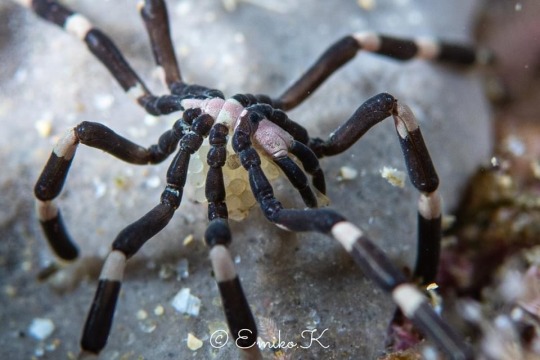
Sea Spider (Stylopallene tubirostris), male with eggs, family Callipallenidae, order Pantopoda, Tasman Sea, NSW, Australia
These creatures are not true spiders, but are in a closely related group, that are completely marine (living in the sea/salt water).
photograph by emikok
Thanks to @ruthlesslistener for the correction. The males carry the eggs!
1K notes
·
View notes
Text
You’ve heard of the itsy bitsy spider, now meet the giant sea spider. 🕷️
Like spiders on land, sea spiders—also known as pycnogonids—come in a range of sizes and appearances. They’re widespread and occur across a variety of ocean environments. The deep sea is home to the giant sea spider (Colossendeis sp.), which can grow larger than a dinner plate. This spindly spider lumbers along the seafloor on jointed, stilt-like legs.
Instead of spinning a delicate web of silk to trap prey, a giant sea spider uses an elongate, tube-like proboscis to slurp up its prey. While studying the unique communities that form around decomposing whale carcasses on the deep seafloor, MBARI researchers observed a giant sea spider crouched over and clinging to the fleshy tentacle of a pom-pom anemone (Liponema brevicorne). Upon closer inspection, the sea spider was actually sucking out the juices inside the tentacle. Another sea spider was even observed clipping a couple of tentacles and taking its dinner to go!
2K notes
·
View notes
Text

Invertober 12, Japanese Spider Crab
#digital art#procreate#bright colours#invertober#invertober2024#invertebrates#sea life#Crab#spider crab#japanese spider crab#sciart
544 notes
·
View notes
Text
That gif of that magnificent creature striding across the seafloor just pushed this from like to love 😆
Had the pleasure of seeing a (tiny!) sea spider in a sample of sea water taken from a pier, many years ago 😀
Round 2 - Arthropoda - Pycnogonida
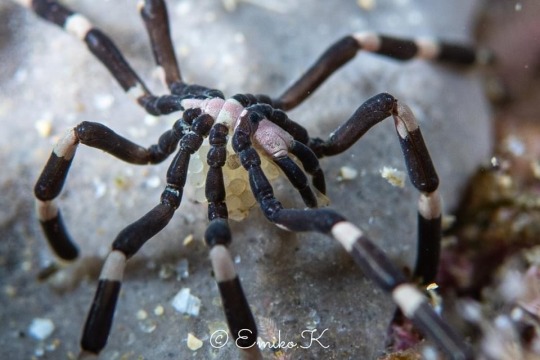
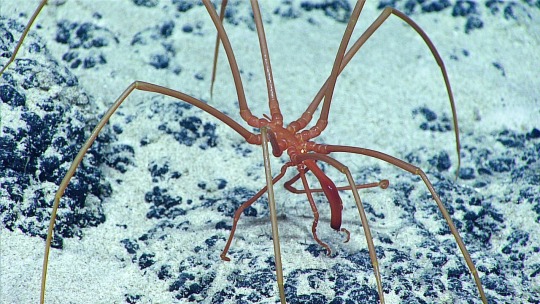
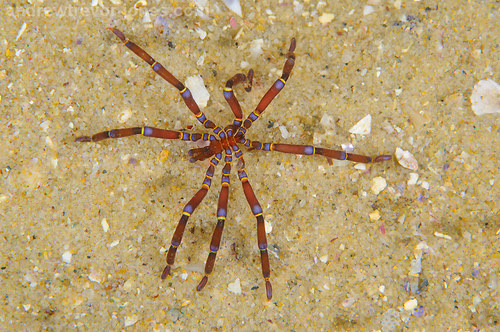
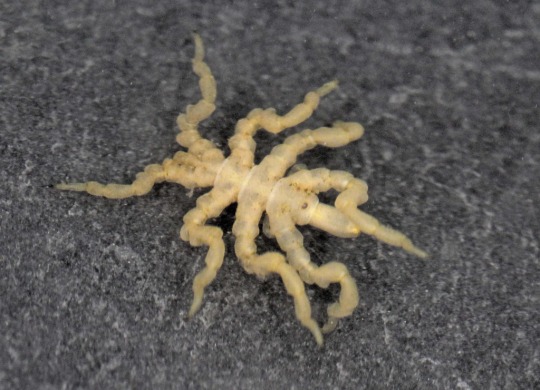
(Sources - 1, 2, 3, 4)
Pycnogonida is a class containing one order: Pantopoda, which means “all feet.” A fitting name for creatures that seem to be made entirely of legs. Commonly called “Sea Spiders��, they are not spiders, nor are they arachnids, but are actually a sister group to all other living arthropods.
Pycnogonids live in most oceans. Most are tiny, living in relatively shallow water, though some can grow to be quite large in antarctic and deep waters. Some pycnogonids are so small that each of their muscles consists of a single cell. They have a proboscis which they use to suck nutrients from soft bodied invertebrates such as cnidarians, sponges, polychaetes, and bryozoans. They can also insert their proboscis into anemones, though this rarely kills the anemone. The pycnogonid digestive tract extends into their legs. They are segmented, with the first body segment (the cephalon) consisting of the proboscis, the ocular tubercle with up to 4 simple eyes, a pair of chelifores, a pair of palps, a pair of ovigers, and the first pair of walking legs. Ovigers are used for cleaning themselves, courtship, and caring for eggs and young. Nymphonidae is the only family where both the chelifores and palps (sensory organs) remain functional. In others, these limbs are reduced or absent, instead relying on a well-developed and flexible proboscis equipped with sensory bristles. Pycnogonids are usually comprised of eight walking legs, but the family Pycnogonidae includes species with ten, and the families Colossendeidae and Nymphonidae include species with up to twelve legs! While most species have up to 4 eyes, some deep-sea species lack them entirely. Pycnogonids do not have a traditional respiratory system, instead absorbing oxygen through their legs and diffusing it throughout their body via hemolymph. Their small, long, thin hearts beat vigorously at 90 to 180 beats per minute, creating substantial blood pressure. Their nervous system consists of a brain which is connected to two ventral nerve cords, which in turn connect to specific nerves. Like other arthropods, they molt their exoskeleton as they grow.
Pycnogonid reproduction involves external fertilization after a brief courtship involving the male stroking the larger female with his ovigers and receiving the eggs if she is responsive. The couple must adjust their position until the genital pores on their legs are perfectly aligned. Only males will care for eggs and young, and in some species only the males will have ovigers while the females do not, as these limbs are used mainly for carrying and cleaning the eggs. Larvae consist only of a head with chelifores, palps and ovigers. Extra segments and legs emerge as it grows into an adult. There are at least four different types of larvae. The typical protonymphon larva is most common, is free living and gradually turns into an adult. The encysted larva spends its larval days as a parasite, finding a host in a colony of polyps, burrowing into one, turning into a cyst, and not leaving the host until it has become a juvenile. The atypical protonymphon larva lives on or within a temporary host such as a clam or polychaete worm, does not encyst or otherwise harm their host, and leaves them as an adult. Lastly, the attaching larva hatches as an embryo and immediately clings to the legs of its father, only leaving once it has two or three pairs of its own walking legs.
The pycnogonid’s cerebral appendages are unique, not found anywhere else among arthropods, except in fossils like Anomalocaris. This could mean that pycnogonids are the last surviving (highly modified) members of an ancient stem group of arthropods that lived in Cambrian oceans.

Propaganda under the cut:
They are good dads. All of them. Perfect fathers made of legs.
Their leg arrangement allows them to move forward, backward, and sideways without turning their body.
The genus Colossendeis (image 2) includes the largest pycnogonids, which live in the ocean depths. Some of them are even bioluminescent! The largest is Colossendeis colossea which can reach a leg span of 70 cm (28 in). However, their body length, including proboscis and abdomen, only reaches 7 cm (2.8 in).
About 20% of the known species of pycnogonids live in Antarctica. The cold never bothered them anyway.
One known species, Ascorhynchus corderoi, is hermaphroditic, having both ovaries and testes.
#animal polls#arthropoda#sea spiders#pycnogonida#pycnogonid#spiders#obviously not but tagging for arachnophobia who might care less about the difference
176 notes
·
View notes
Text

King of Spider Miles
I was going for 'postcard that the Donquixote Family very generously sends to potential business partners in the shitty little town they chose to reside in, so the people will know what their ruler / local mafia boss pirate looks like'
Nah but, I fell for a fictional town that gets almost no screen time at all. I just love that Doflamingo picked a literal garbage dump as his base of operations, sticking his Family into this fortress-looking waste processing plant, allegedly taking in like 100 hopeful but ultimately useless kids as mobster pirate apprentices and then losing all of them because his weirdo brother beat them and threw them in the trash until they ran off crying. What an era.
The landscape of scrap heaps, smoke stacks, industrial brick buildings and the name all speak to my imagination. It's like, Machinarium and Peaky Blinders meets Law's Little Nightmares-esque experience of being a tiny kid in a big hat amongst HUGE monster men. Just very into the Spider Miles vibes and the potential of that place aesthetically.
I also want to know if Doflamingo could use the constant chimney smoke and smog to create sky paths. Just create spiderwebs in the sky all over town and take a little walk.
#I've been wanting to paint those feathers for a while#and went a bit overboard but had a good time#Doflamingo is way too fun to paint#I'll paint that smile eventually but he's not very excited to be king of waste processing#spider miles fan art! because sometimes you become a fan of a town#I live next to an industrial harbor by a misty northern sea and I want more of my bleak home environment represented my favorite fiction#donquixote doflamingo#one piece#bad ninken art
328 notes
·
View notes
Text


low poly Japanese spider crab hours are happening RIGHT NOW DON'T MISS THEM!!!!!!!!!!!!!!!!!!!!!!!
447 notes
·
View notes
Text












A bunch of small watercolours of various species i wanted to paint and didnt have the inspiration and energy to create full scenes with them
Blue bird-of-paradise, red-legged honeycreeper, red-rumped parrot, lesser bird-of-paradise, Minahasa masked owl, Cinnamon ground dove, horned arkys, Common purple & gold moth, bat-wing seaslug, Hula skirt siphonophore, fork-leaved sundew, wild pansy
257 notes
·
View notes
Text
I personally prefer guavas!
A family @wejdan21 recently reached out to me. They're only at 19 percent of their goal. Please donate to them!
This family has five children, they need equipment for the cold!
Tags below
@ashwantsafreepalestine @hehemechief @gryficowa @rob-os-17 @variantsofblue @murderbot @anti-ao3 @a-scary-lack-of-common-sense @squishmallowo @northgazaupdates2 @palestinegenocide @freepalestineeee @sporkkles-irl @el-shab-hussein @teto110 @rosiemissfandomchaos @loathsome-little-creature @nezreblogz @fanartcollectorwriter @wingsfreedom @longlivepalestina @rhubarbspring @spiritflame1 @stoptheantisemitism @jezior0 @soon-palestine @schoolhater @huckleberrycomics @good-old-gossip @gazaevacuationfunds @random-autie-fangirl @myceliacrochet @kyrumption
#free palestine#free gaza#help palestine#long live palestine#from the river to the sea#all eyes on palestine#i stand with palestine#mouthwashing#ace attorney#gravity falls#pokemon#submas#i have no mouth and i must scream#safe utdr#the owl house#tyler the creator#sonic movie 3#sonic the hedgehog#across the spider verse#sonic movie universe#shadow the hedgehog#fullmetal alchemist#fullmetal alchimist brotherhood#monkie kid#lego monkie kid#journey to the west#studio ghibli#ghibli films#moon girl and devil dinosaur#mgadd
263 notes
·
View notes